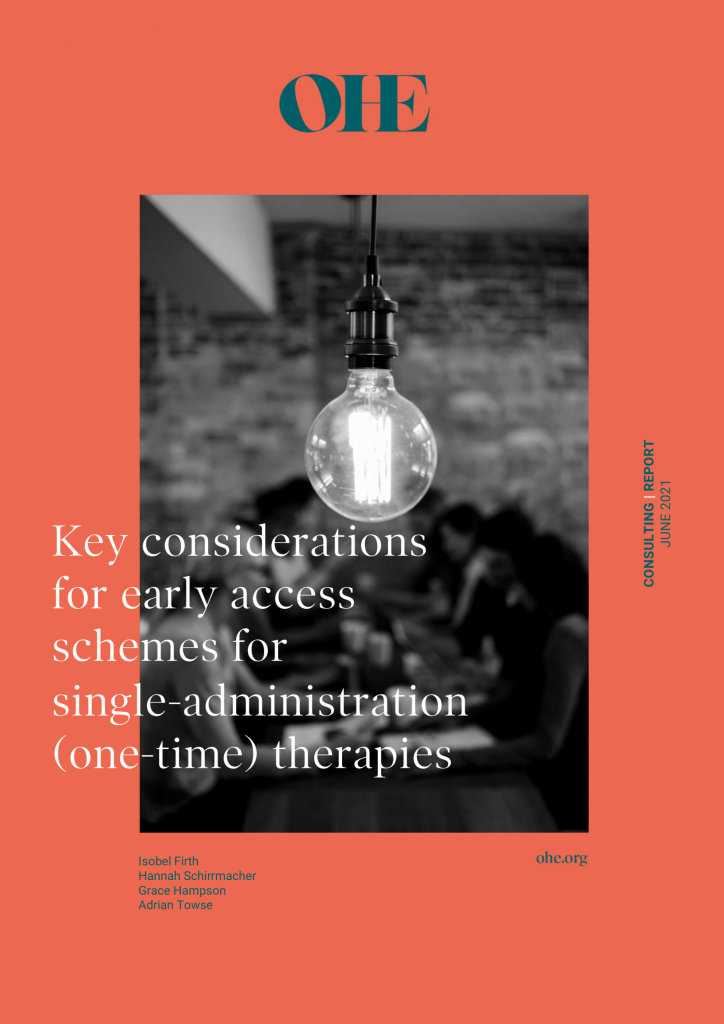Economics of Innovation
Optimal innovation balances willingness and ability to pay with the benefits of future R&D. Our wide-ranging programme aims to promote innovation in health care, increase our understanding of its value, and encourage R&D. New models of innovation should streamline development, reduce costs, and speed patient benefit.

Key Considerations for Early Access Schemes for Single-Administration (One-Time) Therapies
1 June 2021
Early access schemes enable patients in exceptional need to access therapies that are not yet available through their health system. These schemes were not designed for…

Exploring the Financial Sustainability of Gene Therapies
5 January 2021
Gene therapies represent a paradigm shift in medicine, with the potential to address the root causes of chronic diseases. They offer one-time treatment regimens and, in some cases, potentially a cure. As a result, they offer transformative value for patients, physicians, health systems and society. However, with the prospect of more gene therapy approvals there is concern in Europe that these technologies could threaten the financial sustainability of health systems.

The Promise of Gene Therapies: Are We Ready?
1 April 2021
In a webinar held on 16 March 2021, Mary Harney, Annie Hubert and Simone Boselli joined OHE’s Adrian Towse to debate the issues surrounding the adoption of gene therapies. In this interactive report we highlight our 5 key takeaways from the debate with clips, quotes and highlights.

The Value of Diagnostic information (VODI) in Heart Failure – Recognising Value Beyond ‘Beats-Per-Minute’
3 December 2020
Bernarda Zamora presented at the virtual event entitled ‘Value of Diagnostic Information in Heart Failure’, which was organised by Roche Diagnostics. The panel, composed of six…

Opportunities to Increase Efficiency in Healthcare
6 October 2020
Case studies explored more and less successful practices when delivering healthcare across four priority areas (screening, disease management and standardised patient pathways, rational use of medicines and healthcare associated infections). Results were used to simulate cost-savings and patient outcomes.

Establishing a Reasonable Price for an Orphan Drug
11 September 2020
Berdud, Drummond and Towse (2020) propose a method for establishing a reasonable price for an orphan drug. Assuming prices for drugs are set according to incremental…

How Should the World Pay for a COVID-19 Vaccine?
31 July 2020
This year’s OHE lecture addressed the question: how should the world pay for a COVID-19 vaccine? The paper by Adrian Towse and Isobel Firth accompanying the…

Victor R. Fuchs Award for 2020 Goes to Patricia Danzon
23 June 2020
The American Society of Health Economists (ASHEcon) announced Patricia Danzon as recipient of the 2020 Victor R. Fuchs Award. This is given to an economist making…

OHE Authors Develop a Supply and Demand Model of Pharmaceutical Markets to Set Cost-Effectiveness Thresholds to Maximise and Distribute Social Welfare
15 June 2020
OHE authors develop a supply and demand model of pharmaceutical markets to analyse the social welfare distribution between consumers (payers) and developers (industry) to set an…